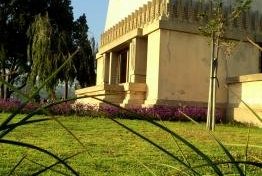
Frank Lloyd Wright is considered one of the great architects of the 20th century, with a far-reaching influence and legacy of design that we encounter frequently in our own homes and communities. In this review, I will attempt to briefly include impressions and relevant information for each building.
Hollyhock House is a real gem in Los Angeles. Barnsdall park is the location of this unique residence. Located in a central location in East Hollywood, this park has wonderful views of Griffith Park and another FLW masterpiece (Google "textile block houses"). Numerous events are held here including wine-tasting, film screenings in the lawn (front of house), and art exhibitions in the adjacent gallery. Robie House, located within the University of Chicago campus in Hyde Park is easy to visit, there is plentiful free parking, and several tours are conducted daily. Furnishings are sparse, but there are some authentic FLW designed chairs on display. The story of how Frank Lloyd Wright Right showed up on the street outside Robie House well into his 80's, cane in hand, to save the house from demolition is worth a listen from your tour guide. Taliesin (East) is a product of at least 3 different rebuilding periods and is a property Wright tinkered with for decades. The property is sublimely situated within a hilly landscape (not on), with surrounding 360 degree views. Significant works of Chinese and Japanese art are found throughout the home. Tours go from a 'highlights' visit to an in-depth exploration of all components of the site. Taliesin West is just outside Scottsdale/Phoenix and the tour(s) require some consideration about what interests you most and the time you have. The property is large, the location is within a desert landscape. The building complex is expansive, eclectic, and often remarkable in its creativity as well as adaptation to the environment. East Asian artwork once again features prominently inside and outside the home. The Herbert and Katherine Jacobs House remains private, and access to the property is restricted to the sidewalk. One highlight is the wall of windows in the back of the property, which can be seen from the nearby sidewalk that wraps around the block. However interesting, I would not recommend spending time and money to reach Madison only to see a bit of the exterior for 10 minutes. Your time would be better spent heading to Spring Green, Wisconsin to tour Taliesin or by heading south to Chicago, which is filled with Frank Lloyd Wright buildings. Which leads me to Unity Temple in Oak Park (worth exploring by foot). Unity Temple went through a recent and considerable restoration effort. Through a self-guided tour, you will be able to balance taking photographs and learning about Wright's vision of thematic styles on display at Unity Temple. I was able to explore this early design by Wright in January 2010 and July 2024. The Guggenheim Museum in New York City can be paired well with exploring Central Park. Admission is quite expensive ($25). The exhibitions are certainly fun to explore as you circle Wright's rotunda design, which the museum curators use to great effect. The final property I visited is perhaps FLW's most iconic work, Fallingwater. I will simply state you must book the 1 hour tour to see the property fully. In each space, Wright's 'Organic Architecture' is fully realized.
I visited all 8 sites components of this world heritage site (year is by completion date)
- 1909 Unity Temple (Oak Park - Chicago IL) *multiple visits
- 1910 Robie House (Hyde Park - Chicago, IL)
- 1911 Taliesin (Spring Green, WI)
- 1921 Hollyhock House (East Hollywood - Los Angeles, CA) *multiple visits
- 1937 Herbert and Katherine Jacobs House (Madison, WI)
- 1938 Taliesin West (Scottsdale, AZ)
- 1939 Fallingwater (Mill Run, PA)
- 1959 The Guggenheim Museum (Central Park - New York City, NY) *multiple visits
Perhaps intriguing is the expressed potential for an extension in the Advisory Body Evaluation.
"Buildings that may be considered for a future extension to the nomination are: Ward Willits House (Highland Park, Illinois, 1902), Tazaemon Yamamura House (Ashiya-shi, Japan, 1918), Alice Millard House / La Miniatura (Pasadena, California, 1923), S.C. Johnson Administration and Building and Research Tower (Racine, Wisconsin, 1935; 1944), Paul Hanna House /Honeycomb House (Stanford, California, 1936), Herbert and Katherine Jacobs House II (Madison, Wisconsin, 1946). The nomination dossier includes information on how these components could further contribute to the proposed outstanding universal value of the series and to the attributes that convey it. ICOMOS considers that, when the assessment of required conditions will be completed, these structures could enhance the integrity of the series." - ICOMOS 2019
Comments
No comments yet.
